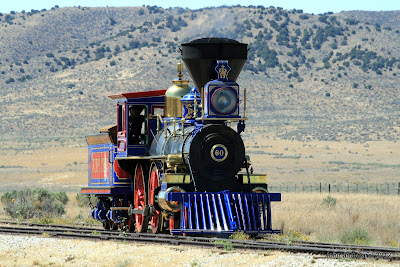In the 1860s the United States Congress approved the construction of a trans-continental railroad. Not much was done about it until after the Civil War ended. The railroad would unite the eastern states to the western states and was seen as important to make us one nation, especially after the divisions of the Civil War.
Thousands of men, including Civil War veterans, out-of-work Irish immigrants and Chinese immigrants recruited from their homeland specially to work on the road bed, used tools like this scoop to level the roadbed

and this shovel to dig through hills and fill ravines,

and incredible amounts of black powder, as well as nitroglycerine, to blast through rock.
On May 10, 1869, two trains met at Promontory Point north of Salt Lake City, Utah, where the last spike of the rail line, one made of gold, was driven into a special laurel wood tie, making it possible to travel all the way from Omaha, Nebraska, to Sacramento, California, by rail.

Union Pacific built across the plains and often had to bring in soft wood ties from along river banks. They looked like this.

The Central Pacific was able to cut down trees in the Sierras and have them cut at sawmills into proper shape.

Here is the gauge used to make sure the rails were exactly 4 ft 8 1/2 inches apart.

We recently both read Nothing Like It in the World by Stephen E Ambrose, the story of the building of the transcontinental railroad. So when we decided to spend 3 nights in Brigham City, a visit to the nearby Golden Spike National Historic Site was a must.
In the photo above, you see a reproduction of the blue and red Jupiter on the left. It was a wood burner that brought Leland Stanford, president of the Central Pacific which built east to Utah from Sacramento, and other dignitaries. I love the smoke stack on wood-burning steam engines.

Engine 119, in red paint, is a coal-burning steam engine. It brought Grenville Dodge of the Union Pacific and other dignitaries.

In the photo of the two trains together, notice the American flag. It has 20 stars. Those arranging the ceremony remembered to bring the trains, the dignitaries, the flag, the speakers, a minister to pray. But they forgot an American flag. A search for one turned up a Civil War veteran who had one from his time in the service. At that time, the U S had only 20 states.
Here are some closeups of the engines.



Several times each day, the two engines are steamed up and run down the track. Here is Jupiter.

And here is Engine 119

We were surprised to see the engines were run so often. It was treat to see them in operation.
This is a replica of the special rail they used for the Golden Spike ceremony.


That was fun to see. When we were there they had people playing all the parts and dressed in period costume. They even pulled a couple of people from the audience to join in.
ReplyDelete